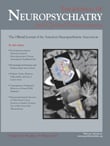Bupropion-Induced Status Epilepticus and Retrograde Amnesia
To the Editor: We present a clinical case of a status epilepticus and retrograde amnesia caused at therapeutic-dose levels of bupropion. Initially marketed as an effective antidepressant, bupropion has more recently been licensed in many countries as an aid to smoking cessation. 1 It is a generally well-tolerated drug. Adverse effects include headache, dry mouth, dizziness, nausea, tremor, constipation, drowsiness, agitation, insomnia, tachycardia, hallucination, allergic reactions, and altering of the seizure threshold. 2 – 4 Bupropion is associated with a dose-dependent increased incidence of seizures. Since the maximum dose has been reduced to 300 mg/day, the seizure rate has decreased to 0.1%. 2
Case Report
A 50-year-old man was found unconscious beside his car at 5:00 a.m., about 300 meters from his work. His wife reported that he usually would not leave home before 5:30 a.m. At 11:30 a.m. he had a generalized tonic-clonic seizure, which was successfully treated with diazepam. He experienced postictal lethargy, confusion, and mild dysarthria. Neurological examination revealed ataxia in finger-to-nose testing. Plantar responses were extensor on both feet. Gait examination was not possible because of undirected ataxia, and he also showed trunk ataxia while sitting. The remainder of the neurological examination was unremarkable. EEG showed beta activity. Retrospectively the alteration of unconscious at 5:00 a.m. was considered postictal.
At 2:30 p.m. the patient was cooperative but not oriented to time, place, and situation. While taking the history, we saw an abrupt tonic contraction of all muscles with a loud “initial cry,” followed by a clonic phase. The complete seizure lasted about 1 minute during which bladder incontinence occurred. Between 5:00 p.m. and 8:00 p.m. four additional tonic-clonic seizures were seen. A bolus dose of valproate, 800 mg, was given intravenously and continuously thereafter (3,200 mg on first day) and the seizure activity finished. After 2:30 p.m., he remained somnolent and confused.
The patient had amnesia for the remainder of the day and had had it for the four preceding days. His wife remembered that he had continuously taken a sustained-release formulation of bupropion (Zyban 150 retard) during the last 14 days. One week prior to the seizures the dose had been doubled to 300 mg bupropion per day. There was no history of seizures, head trauma, alcohol consumption, or liver or kidney diseases.
Brain CT and MRI scans of the brain were unremarkable. CSF analysis showed a normal cell count (1.3/mm 3 ) as well as normal erythrocyte count (0.7/mm 3 ). PCR for viruses (HSV, CMV, EBV, VZV, and enterovirus) were negative. There was no evidence for infection with Borrelia burgdorferi or syphilis. CSF-Protein was elevated to 0.73 g/liter (reference 0.17–0.52) as well as CSF-Lactat to 3.35 mmol/liter (reference 1.1–1.9).
Discussion
There is good evidence to state that bupropion was the reason for the patient’s symptoms. To our knowledge, such severe symptoms, including status epilepticus and retrograde amnesia for 5 days with no other risk factors than taking bupropion, have not been described before. Bupropion appears to be effective in ameliorating symptoms of smoking withdrawal, but physicians should be aware that there is an increased risk for seizures. We suggest performing an EEG prior to bupropion administration.
1. Foley KF, Desanty KP, Kast RE: Bupropion: pharmacology and therapeutic applications. Expert Rev Neurother 2006; 6:1249–1265Google Scholar
2. Fava M, Rush AJ, Thase ME, et al: 15 years of clinical experience with bupropion HCl: from bupropion to bupropion SR to bupropion XL. Prim Care Companion J Clin Psychiatry 2005; 7:106–113Google Scholar
3. Jefferson JW, Pradko JF, Muir KT: Bupropion for major depressive disorder: pharmacokinetic and formulation considerations. Clin Ther 2005; 27:1685–1695Google Scholar
4. Wooltorton E: Bupropion (Zyban, Wellbutrin SR): reports of deaths, seizures, serum sickness. CMAJ 2002; 166:68Google Scholar



